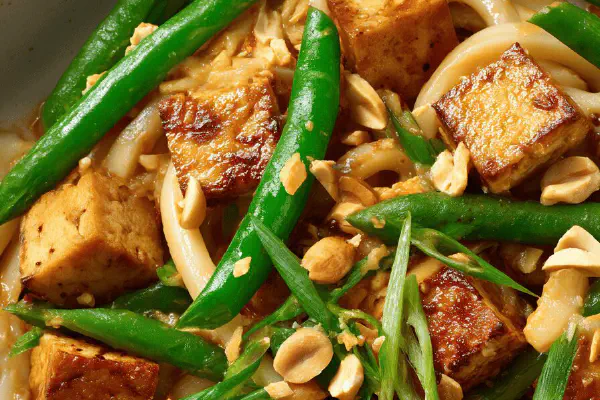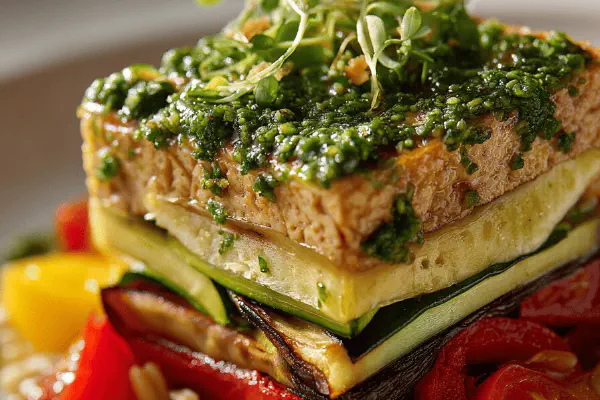Tofu Udon with Green Beans

By Emma
Certified Culinary Professional
Ingredients
Sauce
- 150 ml water
- 75 ml reduced sodium soy sauce
- 50 ml ketchup
- 25 ml peanut butter
- 20 ml packed brown sugar
- 7 ml sambal oelek or to taste
Noodles and tofu
- 500 g firm tofu, crumbled
- 50 ml vegetable oil
- 3 cloves garlic, minced
- 10 ml fresh ginger, minced
- 200 g trimmed green beans
- 4 packages fresh udon noodles 180 g each
- 2 green onions, sliced thin
- 30 g roasted peanuts, roughly chopped (optional)
About the ingredients
Method
Sauce preparation
- 1. Combine water, soy sauce, ketchup, peanut butter, brown sugar, and sambal oelek in a medium bowl. Whisk until smooth. Season with black pepper. Set aside.
Tofu and aromatics
- 2. Heat oil in a large non-stick skillet over medium-high. Add crumbled tofu. Cook, stirring constantly, about 12 minutes until deeply browned.
- 3. Stir in garlic and ginger. Cook 2 more minutes, stirring to prevent burning.
- 4. Pour sauce into pan with tofu. Bring to a boil, then reduce heat and simmer 5–7 minutes, stirring often, until sauce thickens slightly and coats tofu well.
Veggies and noodles
- 5. While tofu simmers, blanch green beans in salted boiling water 4 minutes. Drain with slotted spoon. Rinse under cold water to stop cooking. Cut beans lengthwise in half. Set aside in bowl.
- 6. In same boiling water, cook udon noodles 4 minutes until tender but firm. Reserve 250 ml pasta water before draining noodles.
Final assembly
- 7. Add noodles and green beans to tofu sauce. Toss gently. Add reserved pasta water sparingly to loosen sauce if needed.
- 8. Divide servings into bowls. Top with green onions and peanuts if using. Serve immediately.
Cooking tips
Chef's notes
- 💡 Brown tofu crumbled, not big cubes. Stir constantly over medium-high to build crust. This prevents sogginess. Oil needs to be hot but not smoking. Keep garlic and ginger separate until tofu has browning to avoid burning aromatics. Adds deeper umami from toasted tofu bits.
- 💡 Blanch green beans just 4 minutes in salted boiling water. Don't overcook or they'll lose crunch and color. Rinse immediately under cold water to stop cooking. Halve beans lengthwise after cooling to keep texture crisp and build interest visually. Cutting before blanch makes beans soggy.
- 💡 Reserve noodle water when draining udon. Adding sparingly later loosens tapioca-like thick peanut sauce. Helps coat noodles instead of clumping or drying out. Sauce thickens after simmer with tofu. Adjust with pasta water, not plain water, for best flavor and texture.
- 💡 Simmer sauce after adding to tofu until it slightly thickens and clings. Peanut butter ratio controls viscosity; lowered here for better coating. Avoid adding too much sugar or ketchup—balances acidity and caramel tones. Sambal oelek amount can be adjusted but keep some for heat layer.
- 💡 Add noodles and blanched beans off heat into sauce and tofu mix to stop cooking further. Keeps noodles chewy, beans crisp. Finish with sliced green onions and optional chopped peanuts just before serving for freshness and crunch contrast. Peanuts can be omitted for nut-free version.
Common questions
Can I use other noodles?
Yes but udon best for chewiness. Thinner noodles might get lost in thick sauce. Rice noodles less sturdy. Adjust cook time. Fresh preferred if possible.
How to make nut-free?
Omit peanuts topping. Peanut butter remains for sauce body. Swap with sunflower seed butter if avoids allergy risks. Flavor changes but still thickens. Check heat level without chili if sensitive.
Tofu sticking to pan?
Use non-stick or well-oiled skillet. Crumbled tofu needs frequent stirring. Heat medium-high but not flaming. Pat tofu dry to reduce moisture that makes sticking worse. Stainless steel pans require more oil.
Can leftovers be reheated?
Store in airtight container up to 2 days fridge. Reheat gently in skillet adding reserved pasta water for sauce loosen. Microwave possible but dry risk. Not suitable for freezing due to noodles texture.



